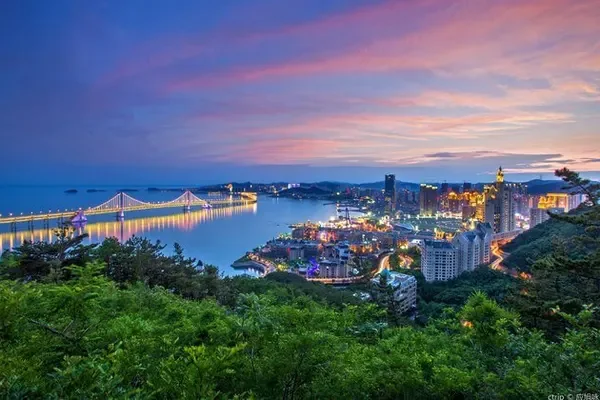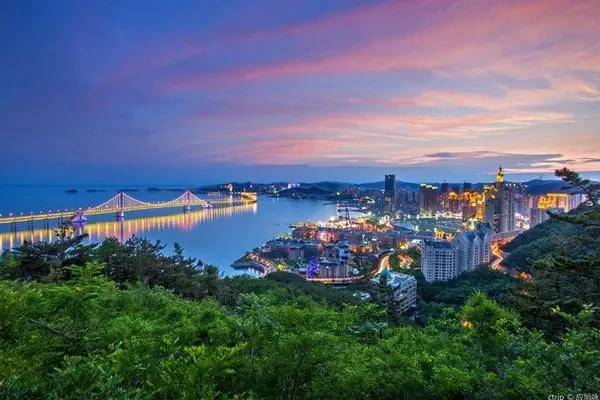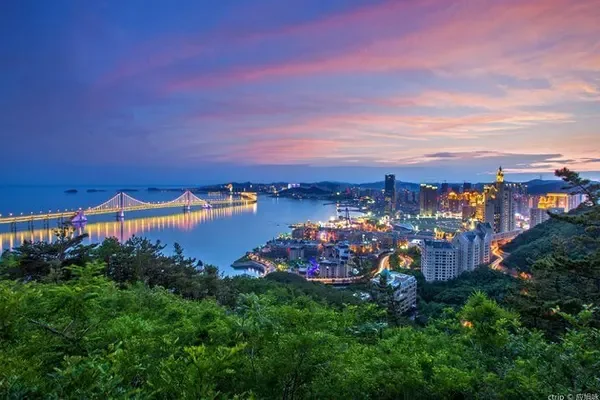There is a magnificent Mianshan Mountain in Shanxi Province. On September 3, 2005, the Beijing self-driving Shanxi tour team participated by the reporter spent a warm and comfortable night at the Fengyichang Folk Custom Hotel in the ancient city of Pingyao, and left Pingyao in the early morning of the next day. The famous Mianshan tourist scenic spot.

On September 3, the weather was beautiful and the weather was sunny and sunny. After starting from Pingyao, the convoy re-entered the expressway and entered the Mianshan Scenic Area after only about two hours' drive. For unknown reasons, when the team was about to arrive at Mianshan, there was still a vast wilderness in front of them, and there was no rudimentary shape of the mountain in sight. But suddenly, continuous mountains appeared in the clouds in the distance. It is said that most of Mianshan is in the clouds all the year round.

After entering the Mianshan Mountain Gate, start to enter the winding mountain road. The scenery along the way is very beautiful. Driving in the mountains and looking down, it is also surrounded by clouds and mist. Through the mist is a vast green field in the haze.

According to relevant records: Mianshan Mountain is located in Jiexiu City, Shanxi Province, and belongs to the Taiyue Mountains. It stretches for more than 50 kilometers and has an altitude of 2566.6 meters. It is named after its stretch of mountains. Mianshan has been famous for more than two thousand years because Jie Zitui took his mother back to hermit and was burned here in the Spring and Autumn Period. After being burned down by the Japanese invaders in March 1940, it has been silent for more than 50 years.

The natural landscape of Mianshan Mountain is strange: the Baofu Rock is so big that it is dissatisfied with more than 200 palaces and one or two million tourists inside; dangerous: the overpass is more than 300 meters away, more than 20 meters away from the top of the mountain, and the bottom is away from the ditch. The bottom is more than 3,300 meters, and the weather is cloudy. People pass on the bridge, and clouds rush under their feet. Therefore, Mianshan not only has the steepness and roughness of the northern landscape, but also the beauty and variety of the famous mountains in the south of the Yangtze River.

Since 1995, Shanxi has built ten tourist areas with 225 scenic spots in five years, and improved a series of service facilities such as transportation, communication, and accommodation. Since its opening in May 1999, Mianshan has set off a tourist craze in Sanjin and even the whole country. It has received millions of tourists. On November 2000 and May 1st in 2001, Mianshan ranked first in Shanxi Province in terms of tourists.

The current Mianshan Scenic Area is mainly composed of cultural landscape and natural scenery. The cultural landscape gathers the culmination of Buddhism and Taoism. It can be said to be rich, refined and ancient.

Bo: There are 88 temples and more than 2,000 halls in Mianshan. The Daluo Palace Taoist complex covers an area of 30,000 square meters, the largest in the country.

Jing: Although Mianshan has suffered many catastrophes, it still retains many ancient buildings, inscriptions and painted sculptures. All the bucket arches and other components of the Stone Buddha Hall in Yunfeng Temple are carefully carved and have high cultural relic value.

Ancient: Tiewa Temple in Mianshan is the earliest mountainous Buddhist temple in my country. Baofo Temple was built in the Cao Wei period of the Three Kingdoms, Huiluan Temple was built before the Tang Dynasty, and Wulong Temple was built before the Northern Song Dynasty.

The geography of Mianshan is peculiar, the annual average temperature is 9.6 degrees, warm in winter and cool in summer, suitable for traveling in four seasons, the romantic mountain flowers in spring, the beautiful waterfalls in summer, the red maple leaves in autumn, and the crystal clear snow in winter. .

The scenery of Mianshan has five characteristics: "no peaks, no wonders, no water, no beauty, no caves, no seclusion, no roads, no dangers, no scenery, no classics". In recent years, it has attracted tourists from all over the country.

The convoy drove up to Mianshan Mountain, and after passing through the archway and entering the cave, there is a beautiful scenic spot. The reporter saw that, in fact, the entire scenic spot is in a long canyon. On one side of the road are continuous high mountains; on the other side are cliffs, and under the rock wall is the bottom of the Grand Canyon. Overlooking the opposite side on the road, there are still rolling green mountains and peaks across the canyon.

The convoy traveled along the mountain road, and first came to the Daluo Palace for sightseeing. Daluo Palace, also known as Daluo Tiangong, is the highest fairyland of Taoism. According to legend, Daluo Palace in Mianshan was built in the period of Tang Xuanzong. Later, due to the war, the original palace has long since disappeared. The current Daluo Palace is built on the mountain. It is a seven-storey antique building with three bright lights and four dark ones. It is more than 110 meters high. The overall construction area of the whole palace is more than 30,000 square meters.

As early as the Spring and Autumn Period, there were Taoist activities in Mianshan. Legend has it that when Jie Zitui saw "Sanqing Mountain, there is Yujing Mountain, and there are seven treasure trees on the mountain covering the heavens in all directions, it is called Daluo", the highest realm of Taoism "Daluo Fairyland", and later generations built Daluo Palace. It is also said that Tang Taizong's sister once practiced Taoism in Daluo Palace, and it was restored during Tang Xuanzong's period. After generations of repairs, it is known as "the first Taoist temple in the world".

The main hall of Daluo Palace is dedicated to Wuming Tianzun, Wuji Yuanjun, and Hong Jun Patriarch. Other main supporting halls are the Hall of the God of Wealth (for Zhao Gongming, the God of Wealth, Bigan and Fan Li, the God of Wealth), the Hall of Rescuing Suffering (for Taiyi to save the suffering Tianzun), the Hall of Sanguan (for the three officials of heaven, earth, and water), Yuanchen Hall (for sixty Tai Sui stars).

Doulao Hall (for Doumo Yuanjun, the mother of all stars), Sanqing Hall (for Yuqing Yuanshi Tianzun, Shangqing Lingbao Tianzun, Taiqing Daode Tianzun), Xingxiu Hall (for the twenty-eight star gods), Lingxiao Hall (for The Jade Emperor, the Heavenly Emperor, the Antarctic Changsheng Emperor, the Ziwei Emperor, and the Houtu Emperor Dizhi) etc.

Many car enthusiasts are very interested in Yuanchen Palace when they visit Daluo Palace. Because the sixty Tai Sui Ye enshrined there contain the patron saints of all attributes.

There is a sign in front of the sixty Tai Sui statues, which records the different ages of people's birth. Everyone can find their Tai Sui according to their birth date. Therefore, Yuanchen Hall is also the only temple in Daluo Palace that has two halls. In fact, it doesn't matter whether you believe in Taoism or not here, the picture is just a fun.

It is said that after visiting the 24 scenic spots in Daluo Palace, tourists will enjoy the wonderful feeling of descending from the "sky". Overlooking the mountain peaches in the gaps of the palace, the flowers are gorgeous and charming, and the gurgling water is green everywhere. It reminds people of the poem of Wang Jian, a poet of the Tang Dynasty, "Peach trees are all over the hillside in the Qin Dynasty, and Mr. Riding a Deer descends to Daluo". Although I didn't have the chance to "ride a deer" today, I also became a "Mr." who descended from Da Luo. Wouldn't it be nice to swim.

It was noon after the tour of the Daluo Palace. The convoy arrived at Yunfeng Shuyuan Hotel in Mianshan where they stayed. There are currently six hotels in Mianshan, and "Yunfeng Shuyuan" is the only hotel built on a cliff in the country. Some car friends joked that sleepwalkers cannot live here, and if they accidentally jump out of the window at night, they will never come back. Although it is a joke, but looking out from the window of the hotel room, the outside is indeed a cliff with deep ravines.

The cultural landscape of Mianshan is mainly concentrated in the front mountain area, while the back mountain is a beautiful natural beauty. After the lunch break, the team drove to Qixian Valley Scenic Area. The riders walked up the mountain from here and experienced a thrilling journey.

After entering the archway of Louxian Valley, the more than 500-meter distance from the ditch to Mosta on the rock is almost a 75-degree cliff, which is no less thrilling than the Qianchi Building in Huashan. There is a saying: Qixian Valley has nine curves and a line of sky, the pedestrian suspension bridge is shocking and safe, and the waterfalls are wonderful and beautiful.

The process of climbing is definitely a challenge to the mental endurance. Sometimes when climbing on a steep ladder, the body can't help but swing with the ladder, but also enjoy the splash of the waterfall falling from the sky. The lower part of some suspension bridges is in the stream. If you don't want to get your shoes wet, you have to bend over and walk slowly on the iron plates embedded in the rock wall. There is a risk of falling if you are not paying attention. Of course, it would not be too dangerous to fall, but it would fall into the gurgling stream. "What you play is the heartbeat", I am afraid it is worthy of the name here.

Climbing more than ten ladders from Qixian Valley, crossing a line of sky, passing by Immortal Stone, Chaofan Cave, Bishang Garden, Butterfly Nest, Turtle Statue Stone, you will arrive at Wailing Slope. Legend has it that Duke Wen of Jin learned that Jie Zitui's mother and son had been burned to death. Facing the dead wood and green smoke, he felt hurt. People and others also wailed, resounding through the forest. This became Wailing Slope, and it is said that the respectful name "One Step" for friends came from this.

After passing Wailing Slope, passing through Zuxia Pavilion, Siyantai, and Hanshi Poetry Stele, you will arrive at Jiegong Temple. There is a statue of Jie Zitui's mother and son in Jiegong Temple, and on the wall of the side hall are exquisite murals of Jie Zitui's life and poems inscribed by celebrities of all ages. From Jiegong Temple, you will go to Baishu Ridge. There are two cypress trees, one big and one small, which people say are the "mother-son cypresses" that symbolize Jiezi and Jiemu. The top of Cypress Ridge is Jie Cemetery.

The Jie cemetery is an oval hill, with a tombstone embedded in the flattened side, and there are several stone tablets from the Yuan, Ming and Qing dynasties beside it. There are several square stone pillars on both sides of the tomb, hidden among the green pines and cypresses. Standing in front of the tomb, remembering the sage who cared about the country and the people more than 2,600 years ago, who did not say much about his achievements, and was righteous and righteous, he suddenly felt a sense of grandeur in his chest.

Thrilling iron plank road (photographed by Cao Qun)
After going down the mountain from Qixian Valley, there is a rather grand stele garden. Numerous inscriptions of celebrities throughout the ages praising Mianshan gather here. It embodies the profound cultural heritage of Mianshan Scenic Area. It is a beautiful landscape of Mianshan.

Shuitaogou Scenic Area is just not far from the exit of Qixian Valley. It has a total length of 15 kilometers, dotted with Cangyan rocks, ancient roads, strange trees, strange rocks, mountain flowers, and wild grasses.

Artificially shaped animals, character allusions, dozens of waterfalls of different sizes, water curtain caves, and dots of teahouses, restaurants, wooden houses, rattan bridges, stone tables and stools constitute the natural scenery of Xiubi Jiangnan.

If Chuanqixian Valley is thrilling and exciting, then Youshuitaogou is as smooth as clouds and flowing water. Along the way, there are more than 30 bends, more than 20 streams crossed, and a small mountain ridge.

People turn with the mountains, water flows around the mountains, the green mountains on the left are towering green, the cliffs on the right stand upright, and the capes extending into the ditch resemble the hideous and strange rocks described in myths; there are also huge rocks like monkeys, elephants, and falcons. All kinds of peculiar mountain and rock landforms make up the strange natural scenery of Yangou, without any sign of artificial carving.

Maybe it was because they put in too much physical and mental and physical strength in the Qixian Valley, and the riders obviously no longer wanted to enjoy the beautiful scenery that is 15 kilometers away. Many people returned after walking for a few kilometers.

Although a day's sightseeing in Mianshan is very hard, the unique scenery here is enough to make people feel that the trip is worthwhile.

The trip to Mianshan was very fruitful, and the riders also subtly familiarized and understood a piece of history in the pleasure of sightseeing. That is the ancient sage Jie Zixiu, a virtuous minister of the Jin Kingdom. His great spirit of "sincerity but faith, merit without merit" is not only admired by future generations, but also sets an example for how to behave.

That night, some riders walked out of the hotel regardless of their physical and mental exhaustion to enjoy the unique night view of Mianshan in China. In the vast night, the lights of the buildings all over the mountain hang in the air, like a fairyland on earth. In particular, those lamp pictures with different names and shapes with "Book of Changes" as the main content reflect the perfect combination of modern technology and religious culture. It is true that this scene should only exist in the sky, and the fairyland on earth is in Mianshan. (Photo: Feng Ganyong)


